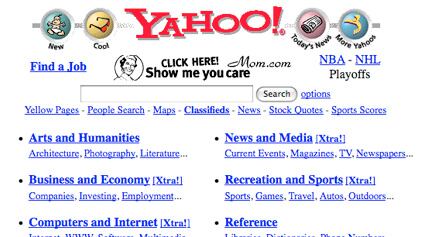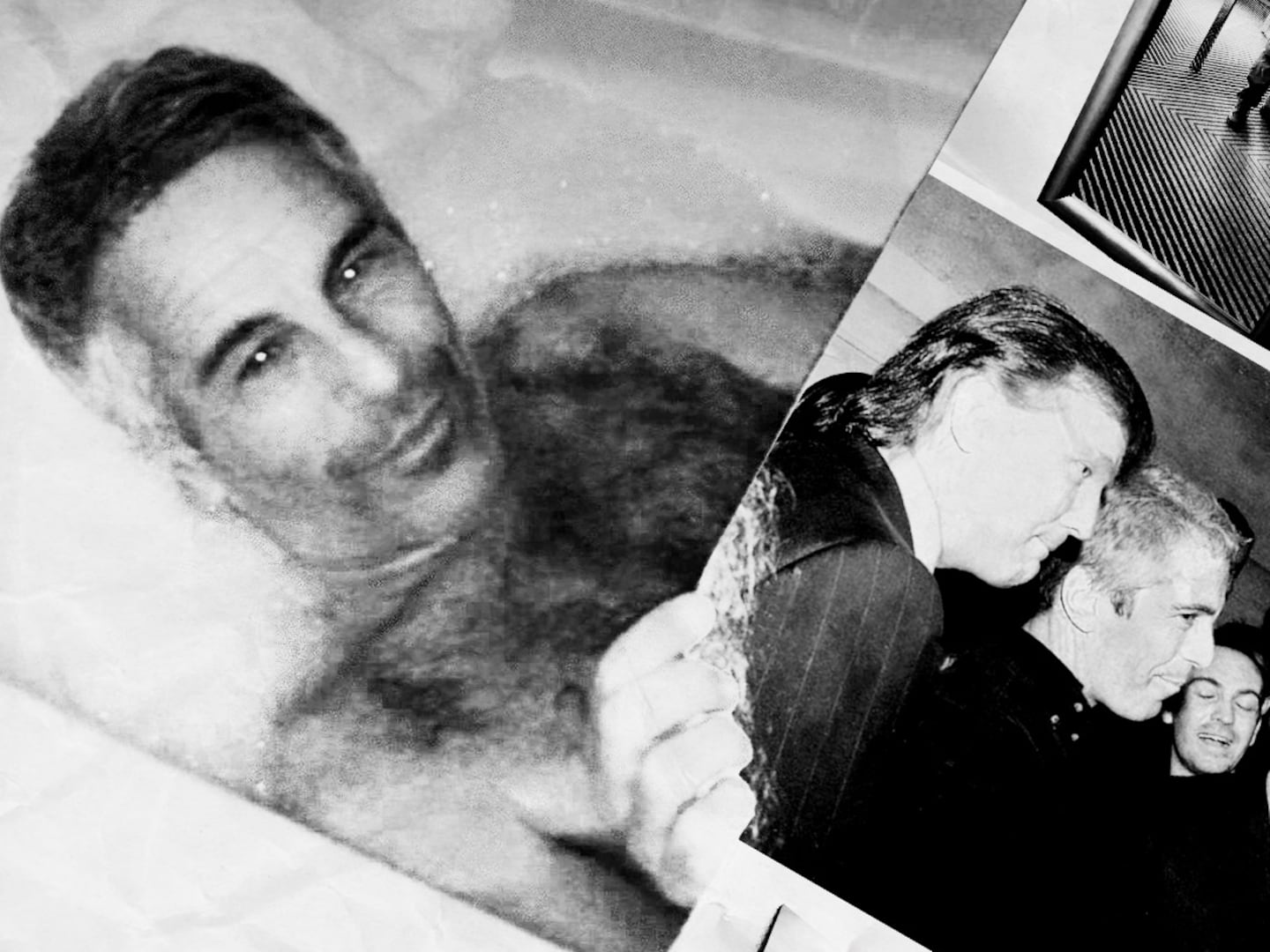
In 2009, Yahoo! is one of the most visited Web sites on the Internet, attracting 3.4 billion page views per day, and it hopes to get even more after it rolls out its new and improved face today. If you’d logged on in May 1997, however, you might have found yourself wondering what all the buzz was about. A bewildering list of headers and sub-headers were listed in bullet-point fashion down the bottom half, while near the top, big buttons marked with vague signifiers like “New” and “Cool” provided additional confusion. An icon marked “Today’s News”—in the ‘90s, news happened once per day—featured a rolled-up broadsheet to assure visitors that the information within was legit.

After entering McDonalds.com in 1997, visitors found the site quickly devolved into something that, today, could be created by a toddler with halfway-decent Photoshop skills. Ronald invited you to drag a picture of a Double Mac into the mouth of a hungry child—and then told you to “just hit reload” to do it all over again. And while McDonald’s may not be known for advertising its nutrition facts, back in the day it utilized its Web site to emphasize the small: “If you’re interested in the fine print, now is an opportunity to check it out,” read a large link to its long list of Terms and Conditions.

Even in 1996, the New York Times had one of the Internet’s most visited Web sites, but it certainly didn’t look it. The content was the draw— if you could find it—as the layout was clearly reluctant to abandon the comforting template of physical newsprint. A link highlighted in yellow suggests the “Table of Contents” is your most important click, “Classifieds” (still the newspaper’s cash cow) are prominently featured right below “News by Category,” and a section called “CyberTimes” employs the zippy lingo of the Information Superhighway.

In 1997, MTV.com looked like a fan site designed on a rickety Gateway 2000. With a ‘90s-psychedelic background, the designers made the odd choice of carefully avoiding the center of the screen, locating links and logos in small font around the periphery. With a few clicks, you could follow the cast of Real World Boston, and discover the Backstreet Boys’ As Long as You Love Me and Will Smith’s Gettin’ Jiggy With It. Toward the bottom, a huge link invited users to work for MTV Online—apparently the site felt it needed some help.

“Good Morning,” beamed the White House’s Web site in 1998. “Welcome to the White House.” (Whether this message changed as morning changed to afternoon and evening is unclear.) Beneath the cutting-edge waving flags and photo of the fountains outside 1600 Pennsylvania Ave., a visitor to Whitehouse.gov in the late ‘90s could learn more about Bill Clinton and Al Gore: “Their accomplishments, their families, and how to send them electronic mail.”

Who could forget the sound that defined the pre-Y2K Internet era: that crackling, deliberate hum of America Online struggling to sign on to the Internet, followed (hopefully) by a bright, “Welcome! You’ve got mail!” AOL had more than a third of all Internet users in 1997, and even though its $182 billion merger with Time Warner in January 2000 was doomed, the site remained as friendly as ever, with its little jogging Instant Message man and cartoon mailbox reminding users that email needn’t be scary—it’s just like real mail! In fact, you don’t even need a stamp!

Before it became an addictive social tool for everyone under 35, Facebook was known as Thefacebook, and functioned as a networking site for college students exclusively. In fact, in 2005, Facebook was still small enough to announce its new networks on its home page—something that would be quite impossible today, with some 250 million users.

Remember when all it took to get Jerry Maguire on VHS delivered instantly to your door was a few clicks on UrbanFetch.com? The quirky, now-defunct Web site once boasted it would bring you virtually anything you wanted within the hour, from Clean & Clear pore strips to, as its June 2000 Web site suggests, Britney Spears’ Oops! I Did It Again. The service folded soon after this screenshot was taken.

When Stanford Ph.D. students Larry Page and Sergey Brin began work on a search engine in 1996, the pair could hardly have imagined they would one day be worth $18.5 billion each because of it. And though Google hasn’t changed much about its appearance, including keeping its colorful lettering from 1998, it did tone itself down slightly by losing its Yahoo!-esque exclamation point.

Apple has always been an early adopter. When the company registered its Web site in 1987, it became the internet’s 64th dot-com address. A decade later, however, Apple.com still lacked the slick layout of its current Web site, offering free CD-ROMs but few come-hither photos of beautiful hardware. (The one computer featured is a laptop with a black-and-green screen.) A QuickTime demonstration, however, did feature video, something almost unheard of in the dark days of dial-up.

Started in 1996 by Garrett Gruener and David Warthen in Berkeley, California, this Web site featured a “valet” by the name of Jeeves who would fetch the answers to requests made in full-sentence question form. In this screenshot from 1997, you can see the sharply dressed gentleman icon (illustrated by Marco Sorensen). By 2005 plans were announced to phase out Jeeves, resulting in the simple and more traditional Ask.com.

After it launched in 1995, AltaVista (originally altavista.digital.com) soon became one of the most popular (and self-proclaimed “powerful”) search engines on the Web. When it was re-launched by Compaq in 1999, it hoped to compete with Yahoo!. But at that point, Google was already beginning to take over the world, and today, AltaVista (now owned by Yahoo!) is still functioning, but used mainly by search-engine eccentrics. This screenshot from 1997 shows news that AltaVista would be adding “relevant paid links” and dares users to “Book your own airline tickets online!”

Back in 1998, AT&T featured information on the “9-0-# phone scam,” and boasted their “Let Freedom Ring” Digital One Rate—only 9 cents per minute when calling outside of your town! And, of course, the gigantic cellular phone with a two-inch rubber antenna reminded visitors that the American Telephone and Telegraph company was zooming into the 21st century.

The Philadelphia Inquirer is the third-oldest surviving daily newspaper in America, and when it got its Web site up and running in 1999, it looked nearly as antiquated. Much like that of many newspapers’ sites at the time, Philly.com featured one or two news stories above the fold, along with a whole lot of useless links. It called itself “The Region’s Home Page” and, like many media sites at the time, shared its space with the local TV news affiliate, Channel 6 Action News.

Would you trust the people who designed this Web site to engineer a spacecraft? The large-print buttons and tricolor graphics suggest a computer mid-freeze, proving that even NASA had a rocky start in the earliest days of the World Wide Web.





